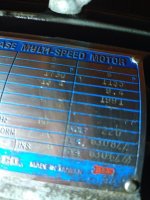UtahSmitty
Plastic
- Joined
- Jan 9, 2018
- Location
- Northern Utah, USA
I just purchased a Takisawa TSL 1000CD lathe that had been stored in a shed under tarps.
It has a lot of rust, and when I saw the pictures in the classified ad it looked like it was too rusty. However, I drove the 180 miles round trip to look at it, and found that the ways were actually in pretty good shape. The chuck and other parts were more rusty but I'm hoping the internals will be in good shape.
I pulled the cover off the headstock and all the gears were in great shape--no chipped teeth and no rust. The oil was halfway up the sight glass so that helped things for sure.




So, I now have some questions... I've done a search throughout the forums and have come up empty...
1. The manual specs Mobil Vactra #2 for the ways, and Mobile Velocite #6 for the headstock, carriage, etc. Quantity wise it says "2.5" for the headstock, and ".5" for the apron--no units. I assume this is liters... can anyone confirm this. Are there any other lubes that you'd recommend versus the Mobil products?
2. The lathe has a 2-speed (3 hp and 5hp) 3 phase motor. I want to run the lathe with a VFD...is it practical to run the 2 speed motor with a VFD, or should I get a single speed 5 hp 3phase motor to replace it? I assume the motor speed is ~3,500 rpm as the top spindle speed is 1800 rpm.
3. The tailstock live center has a bad bearing... feels gritty when spinning. I can remove the cover, and see the bearing, but the base of the center is one piece... how do I get the bearing out of it?

4. I'd rather avoid using flood coolant---most of my machining will be one-off parts primarily in aluminum. I have a mist coolant system I've never tried... is it a viable alternative?
Thanks in advance for any suggestions... I've posted some pictures of the lathe, and will post the updates as I go through the process.
Regards,
Utah Smitty
It has a lot of rust, and when I saw the pictures in the classified ad it looked like it was too rusty. However, I drove the 180 miles round trip to look at it, and found that the ways were actually in pretty good shape. The chuck and other parts were more rusty but I'm hoping the internals will be in good shape.
I pulled the cover off the headstock and all the gears were in great shape--no chipped teeth and no rust. The oil was halfway up the sight glass so that helped things for sure.




So, I now have some questions... I've done a search throughout the forums and have come up empty...
1. The manual specs Mobil Vactra #2 for the ways, and Mobile Velocite #6 for the headstock, carriage, etc. Quantity wise it says "2.5" for the headstock, and ".5" for the apron--no units. I assume this is liters... can anyone confirm this. Are there any other lubes that you'd recommend versus the Mobil products?
2. The lathe has a 2-speed (3 hp and 5hp) 3 phase motor. I want to run the lathe with a VFD...is it practical to run the 2 speed motor with a VFD, or should I get a single speed 5 hp 3phase motor to replace it? I assume the motor speed is ~3,500 rpm as the top spindle speed is 1800 rpm.
3. The tailstock live center has a bad bearing... feels gritty when spinning. I can remove the cover, and see the bearing, but the base of the center is one piece... how do I get the bearing out of it?

4. I'd rather avoid using flood coolant---most of my machining will be one-off parts primarily in aluminum. I have a mist coolant system I've never tried... is it a viable alternative?
Thanks in advance for any suggestions... I've posted some pictures of the lathe, and will post the updates as I go through the process.
Regards,
Utah Smitty





